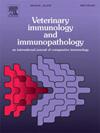Hamster and mouse CD25+CD4+ T cell responses to the C-terminal of leptospiral Ig-like protein A
IF 1.4
3区 农林科学
Q4 IMMUNOLOGY
引用次数: 0
Abstract
Leptospirosis is a major public health problem in humans and animals worldwide. The variable carboxy-terminal domain 7–13 of LigA (LigAc) is currently the most promising immunogen for the leptospirosis subunit vaccine. Its protective evidence was investigated in susceptible hamsters whose immunity was mostly based on the knowledge of resistant mice. The difference in immunity of these two animals might be an obstacle to successful vaccine development. The protective immunity induced by LigAc was reported to be specific antibodies while T-cell-mediated immunity has never been investigated. We reported for the first time that hamsters and mice gave dissimilar T-cell responses. Mice and hamsters were divided into 3 groups: an adjuvant plus recombinant LigAc (rLigAc) immunized, an adjuvant-injected, and a negative control group. Immunizations were done three times at 2-week intervals. The rLigAc-specific IgG antibody titers in rLigAc immunized mice and hamsters were significantly higher than in the control groups but no significant difference between the animals. The percentages of hamster CD4+ T cells were significantly higher than those of mice. Mouse CD25+CD4+ T cells responded to rLigAc significantly higher than hamsters. Interestingly, the rLigAc significantly reduced the percentage of IFN-γ+CD4+ cells in mice (≅30 %) and more decrease (≅70 %) was found in hamsters. Remarkably, it also reduced considerably hamster IL-4+CD4+ T cells (≅80 %) but an extremely low decrease in mice (≅20 %). Our result indicated that mice and hamsters gave different responses to leptospiral antigens which might be the possible key that plays a role in the outcome of disease.
仓鼠和小鼠CD25+CD4+ T细胞对钩端螺旋体igg样蛋白A的c端反应
钩端螺旋体病是全世界人类和动物的一个主要公共卫生问题。LigA的可变羧基末端结构域7-13 (LigAc)是目前最有希望用于钩端螺旋体病亚单位疫苗的免疫原。在易感仓鼠中调查了其保护性证据,这些仓鼠的免疫主要基于对耐药小鼠的了解。这两种动物的免疫力差异可能是成功研制疫苗的障碍。据报道,LigAc诱导的保护性免疫是特异性抗体,而t细胞介导的免疫从未被研究过。我们首次报道了仓鼠和小鼠产生不同的t细胞反应。将小鼠和仓鼠分为3组:佐剂加重组LigAc (rLigAc)免疫组、佐剂注射组和阴性对照组。免疫接种每两周进行三次。rLigAc免疫小鼠和仓鼠的rLigAc特异性IgG抗体滴度显著高于对照组,但动物间无显著差异。仓鼠CD4+ T细胞百分比明显高于小鼠。小鼠CD25+CD4+ T细胞对rLigAc的应答明显高于仓鼠。有趣的是,rLigAc显著降低了小鼠中IFN-γ+CD4+细胞的百分比(30 %),而在仓鼠中发现了更多的降低(70 %)。值得注意的是,它也大大减少仓鼠IL-4+CD4+ T细胞(= 80 %),但极低的减少小鼠(= 20 %)。我们的结果表明小鼠和仓鼠对钩端螺旋体抗原的反应不同,这可能是影响疾病结局的关键。
本文章由计算机程序翻译,如有差异,请以英文原文为准。
求助全文
约1分钟内获得全文
求助全文
来源期刊
CiteScore
3.40
自引率
5.60%
发文量
79
审稿时长
70 days
期刊介绍:
The journal reports basic, comparative and clinical immunology as they pertain to the animal species designated here: livestock, poultry, and fish species that are major food animals and companion animals such as cats, dogs, horses and camels, and wildlife species that act as reservoirs for food, companion or human infectious diseases, or as models for human disease.
Rodent models of infectious diseases that are of importance in the animal species indicated above,when the disease requires a level of containment that is not readily available for larger animal experimentation (ABSL3), will be considered. Papers on rabbits, lizards, guinea pigs, badgers, armadillos, elephants, antelope, and buffalo will be reviewed if the research advances our fundamental understanding of immunology, or if they act as a reservoir of infectious disease for the primary animal species designated above, or for humans. Manuscripts employing other species will be reviewed if justified as fitting into the categories above.
The following topics are appropriate: biology of cells and mechanisms of the immune system, immunochemistry, immunodeficiencies, immunodiagnosis, immunogenetics, immunopathology, immunology of infectious disease and tumors, immunoprophylaxis including vaccine development and delivery, immunological aspects of pregnancy including passive immunity, autoimmuity, neuroimmunology, and transplanatation immunology. Manuscripts that describe new genes and development of tools such as monoclonal antibodies are also of interest when part of a larger biological study. Studies employing extracts or constituents (plant extracts, feed additives or microbiome) must be sufficiently defined to be reproduced in other laboratories and also provide evidence for possible mechanisms and not simply show an effect on the immune system.

 求助内容:
求助内容: 应助结果提醒方式:
应助结果提醒方式:


